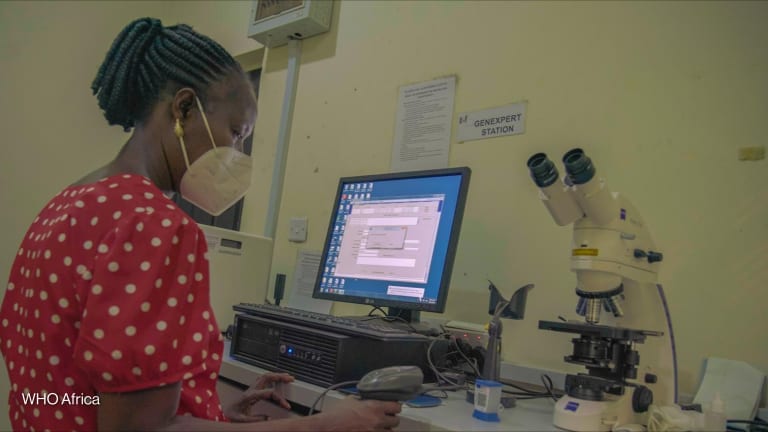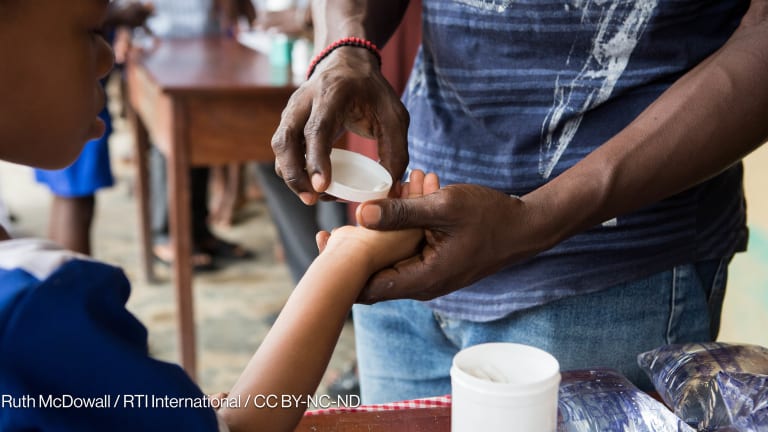Back from retirement, Marie Staunton shifts focus from girls to leprosy
Drawing on lessons learned from her time with Plan, Marie Staunton shares how she intends to increase awareness and improve the fight against leprosy in her role as interim chair for ILEP.
If Marie Staunton were to identify the exact moment when the international aid architecture began to change, the former Plan International director would point to the earthquake and tsunami that devastated Indonesia, Sri Lanka, India and Thailand in 2004. Before this, “it was possible for development agencies like Plan to say, ‘We do not do emergencies.’ But no longer,” Staunton told Devex. The disaster swept away years of work in India, Indonesia and Sri Lanka, leading the organization to incorporate not just humanitarian aid but also disaster resilience into its programs. “Now, wherever you are — whether there are floods in Pakistan, typhoons in the Americas or election violence in many countries, emergencies affect your work everywhere,” she stressed. “You must be prepared and ensure those you work with are prepared for disasters.” In 2012, Staunton left Plan after 12 years at the helm and was honored as a Commander of the Order of the British Empire in recognition of her services to international humanitarian aid. This year, she was appointed interim chief executive for ILEP, the International Federation of Anti-Leprosy Associations. “I tried retirement in 2013,” she shared. “It did not work for me. I think it’s a generational thing. We’re different from our parents. We’re like the bounce-back kids. Just like returning to work after maternity leave I have bounced back from retirement.” Defining a new strategy to combat leprosy Staunton was brought in to develop a new strategy for ILEP, an association comprising 14 nongovernmental organizations that coordinate work in 63 countries. She was also tasked to identify areas where ILEP can spend $2.5 million in research funding, as well as support a technical commission of world experts on leprosy. Increasing leprosy awareness is one vital component of her work. Despite widespread belief that leprosy is on the wane, there are still about 250,000 new cases recorded every year. “Leprosy shouldn’t be a health problem, as there is a cure,” Staunton said, “but the health services aren’t getting to enough of the very poor in high endemic countries like India or Brazil.” Another element in the fight against leprosy, according to ILEP’s interim chief, is for organizations on the ground to support self-help groups of those affected by the neglected disease. In India, for example, a local woman cured of leprosy fought for — and won — pensions for afflicted people. “It is so unjust,” Staunton said of the bad deal leprosy inflicts on women. “Women who have leprosy can’t own land in some countries, they can’t get married, nor can anyone else in their family.” There is even a bill in the Nepalese parliament that proposes having leprosy as grounds for annulment. Learning from those around you One thing Staunton has learned from her years at Plan was that “you can’t find out what is happening if you are just sitting on your own.” She moved out of her private office so she can have a better grasp of what is happening in the organization, even learning from the experiences of front-line staff. Through this, Staunton realized that Plan was not leveraging its strengths and needed to add value. This led to a reprioritization and a targeted focus on girls, which at that time was a relatively unnoticed issue. Further, when Plan was looking at new forms of humanitarian aid, they discovered “someone working quietly in Guinea, who had developed an effective system of cash transfers.” One good lesson Staunton learned from this is that these pockets of good practice need to be mainstreamed across all of Plan’s programs. This form of leadership is something she has now carried over to ILEP. When she was drawing up ILEP’s strategy she realized the importance of tracing its added value, which “you can’t do by sitting in one place,” so she spoke to 60 people working in the field, throughout the organization and stakeholders. “When you start work in any organization, you have a passion to do something, but you must be aware of your own ignorance, and spend time learning from others,” she said. Leveraging private sector partnerships ILEP currently works with pharmaceutical company Novartis, which provides leprosy drugs for free. Novartis also supports ILEP members in rolling out contact tracing to locate people who could be infected. In pilot runs, contact tracing was shown to reduce leprosy incidences by 54 percent. “These public-private partnerships are not unusual in the health sector,” Staunton explained, “because most companies practice corporate social responsibility, and want to be seen as a responsible drug company.” Philanthropic organizations and foundations are increasingly playing an important role in global health in general, but more specifically in neglected tropical diseases. The Bill & Melinda Gates Foundation, Staunton highlighted, has raised awareness for diseases such as leprosy by driving work forward and bringing different actors — NGOs, donors, academics and government agencies — together to tackle the problems. The foundation was one of the forces behind the London Declaration on NTD in 2012, which has been described as “a tipping point” to fight the forgotten disease. “Gates has been positive in that it has changed the discourse in philanthropy from ‘why’ to ‘why not,’” ILEP’s interim chief said. She did note that the foundation’s target-based approach needs to be balanced with serious health system strengthening, as the recent Ebola crisis has shown. Check out more insights and analysis provided to hundreds of Executive Members worldwide, and subscribe to the Development Insider to receive the latest news, trends and policies that influence your organization.
If Marie Staunton were to identify the exact moment when the international aid architecture began to change, the former Plan International director would point to the earthquake and tsunami that devastated Indonesia, Sri Lanka, India and Thailand in 2004.
Before this, “it was possible for development agencies like Plan to say, ‘We do not do emergencies.’ But no longer,” Staunton told Devex. The disaster swept away years of work in India, Indonesia and Sri Lanka, leading the organization to incorporate not just humanitarian aid but also disaster resilience into its programs.
“Now, wherever you are — whether there are floods in Pakistan, typhoons in the Americas or election violence in many countries, emergencies affect your work everywhere,” she stressed. “You must be prepared and ensure those you work with are prepared for disasters.”
This story is forDevex Promembers
Unlock this story now with a 15-day free trial of Devex Pro.
With a Devex Pro subscription you'll get access to deeper analysis and exclusive insights from our reporters and analysts.
Start my free trialRequest a group subscription Printing articles to share with others is a breach of our terms and conditions and copyright policy. Please use the sharing options on the left side of the article. Devex Pro members may share up to 10 articles per month using the Pro share tool ( ).
Daphne Davies is a London-based freelance journalist and consultant with more than 30 years' experience in international development. She has worked with the U.N., the European Union, national governments and global civil society organizations, including Amnesty, WWF and LDC Watch. Her expertise is in monitoring government policies in relation to international cooperation. Her interests are in sustainability, social and economic matters, women and least developed countries.








